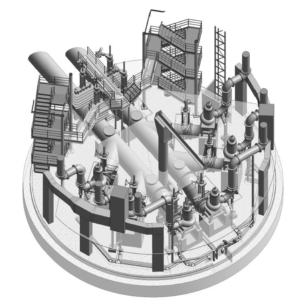Work to begin in early August on the next elements of the Front of Plant Project
The Regional Environmental Sewer Conveyance Upgrade (RESCU) Program will support the safety and reliability of the community’s wastewater system and protect the San Francisco Bay through rehabilitating, re-purposing, and constructing new facilities. One of the RESCU program projects is the Front of Plant project, which consists of the design and construction of the Receiving Lift Station, Headworks Facility, Odor Control Facilities, Influent Connector Pipe, Civil site work, Emergency Overflow pipe to storage basin and related process support systems. Work is being implemented in stages under a Progressive Design-Build procurement process.
Excavation of various elements at Silicon Valley Clean Water’s Front of Plant project has commenced in early August and will take three months to complete. This new facility ensures the safety and resilience of Silicon Valley Clean Water’s operations, and the structure will be constructed on SVCW property at 1400 Radio Road as part of the SVCW RESCU Program. Front of Plant project construction is planned through 2022.
This aspect of the project including the receiving lift station, surge tower flow and splitter structure shafts will make it possible for SVCW to transfer influent wastewater flow to the new headworks facility for preliminary treatment. The headworks facility will consist of mechanically-cleaned screens and grit removal tanks. The screened and de-gritted flow will be conveyed to the wastewater treatment plant influent mix box, which is located upstream of an existing, smaller screening facility. At the new headworks, the collected screenings and grit will be processed by washer-compactors for the screened materials (i.e., rags and other fibrous material) and by grit washer dewatering units. Both streams of washed inorganic solids (i.e., screenings and grit) will be consolidated in roll-off bins dedicated to each type of waste material that are to be hauled offsite for disposal. The washing and compacting of each waste stream reduces volume and eliminates residual odors from these materials.
Construction and excavation of the project elements involve building a support-of-excavation structure consisting of the outer ring for each of the two shafts. The rings were excavated to the full depth of the shafts in sections (also referred to as panels) before concrete was placed to form the walls of both shafts. With the placement of the interconnected concrete panels completed, the upcoming excavation of the shaft interior can proceed to remove soil from within a stable concrete structure. The soil will be removed for disposed of at the plant site.
Once the contractor reaches the correct excavation elevation, approximately 90 feet to the bottom of each shaft, a concrete base slab will be placed to complete the structures.
Completion of this aspect of the project will allow SVCW and its construction partner, Shea Parsons Joint Venture (SPJV), to proceed with building the functional elements of the Front of Plant project, including constructing the components of the receiving lift station in the shaft to deliver raw wastewater from the gravity pipeline discharge to the headworks facility at the surface.
The construction team will also prepare the receiving lift station shaft, constructed immediately adjacent to the shaft, to receive the Tunnel Boring Machine as it completes the tunneling work for the new gravity pipeline. After the Tunnel Boring Machine has been removed following completion of tunneling, the construction team will outfit the interior of the shaft for management of raw wastewater flows that will be part of the Front of Plant project.

Picture of the bottom of the receiving lift station structure.